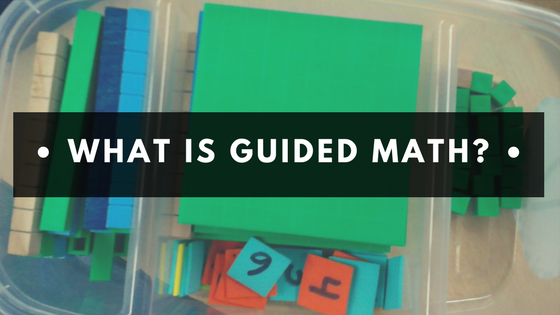
What is Guided Math?

Fall has become one of my favorite times of the year. I love the colors, the cool air, sweatshirts, AND it's the beginning of my seminar season! For the third year in a row, I am getting ready to embark on my guided math seminar tour across the country.
When thinking about where to begin with math content, I decided I would start with the topic that is very close to my heart, guided math. This will be a six-week series of posts:
- Week 1: What is guided math?
- Week 2: Shifting our math instruction to develop mathematical thinkers
- Week 3: Whole group instruction in a guided math classroom
- Week 4: Small groups with a purpose
- Week 5: Putting it all together: organization and procedures for guided math
- Week 6: Workstations that work
I love asking teachers and administrators, "What does guided math mean to you?" Usually the responses are pretty similar: small groups, differentiation, games, using manipulatives. But, when I ask what does this look like in your classroom, the room tends to get pretty quiet. Someone often volunteers that she tries to have her students rotate through three or four stations, about every 15-20 minutes, during which time she is a station and gets to see all her students in a small group each day.
For most teachers that is the exact picture they paint in their minds when they hear the term "guided math". This isn't incorrect, but it's missing the true meaning of guided math. Guided math is a FRAMEWORK for math instruction in your classroom. There are several ways you can manage this framework, such as the way I described above. However, the picture I painted isn't the ONLY way, and in fact, that organizational strategy didn't work for me in my classroom. My fourth post in this series will address different ways you can manage your time and I will share different options for putting all the components together. The one point I want to stress right now, there is NO "one way" to do guided math. Stay tuned for more on that point soon ...
Within a guided math framework, the following components should be included: daily number sense routines, whole group instruction, small group instruction, and workstations. Embedded into each component should be: vocabulary, because math IS a language; the use of math journals, because we want students writing in math; and fluency, with emphasis on mental math strategies.
During the next six weeks I will be doing a series of posts breaking down the different aspects of guided math. If you like what you are reading, and you interested in learning more, I would love for you to join me at one of my Guided Math Seminars!
Until next week, when we focus on "Shifting Our Instruction", enjoy this week's "Plus-One."
Are you tired of dice rolling everywhere when your students are playing a game? Try using "

math shakers". You can purchase the classroom math shakers that you see pictured, or you can purchase medicine pill containers sold at all pharmacy locations or online. Make sure you buy the "extra-wide" containers so the dice will roll. You can take off the letters on the outside with nail polish remover. On either shaker, students can use dry-erase markers to write the numbers they roll on the outside of the container.
These are perfect to use when asking students to generate their own numbers for computation. Instead of using worksheets, have students shake their shakers to come up with the numbers to use. There are so many uses and games you can do with math shakers. For easy, fun activities, visit one of my favorite sites, Box Cars and One-Eyed Jacks and look for the book Math Shakers, by Jane Felling.


